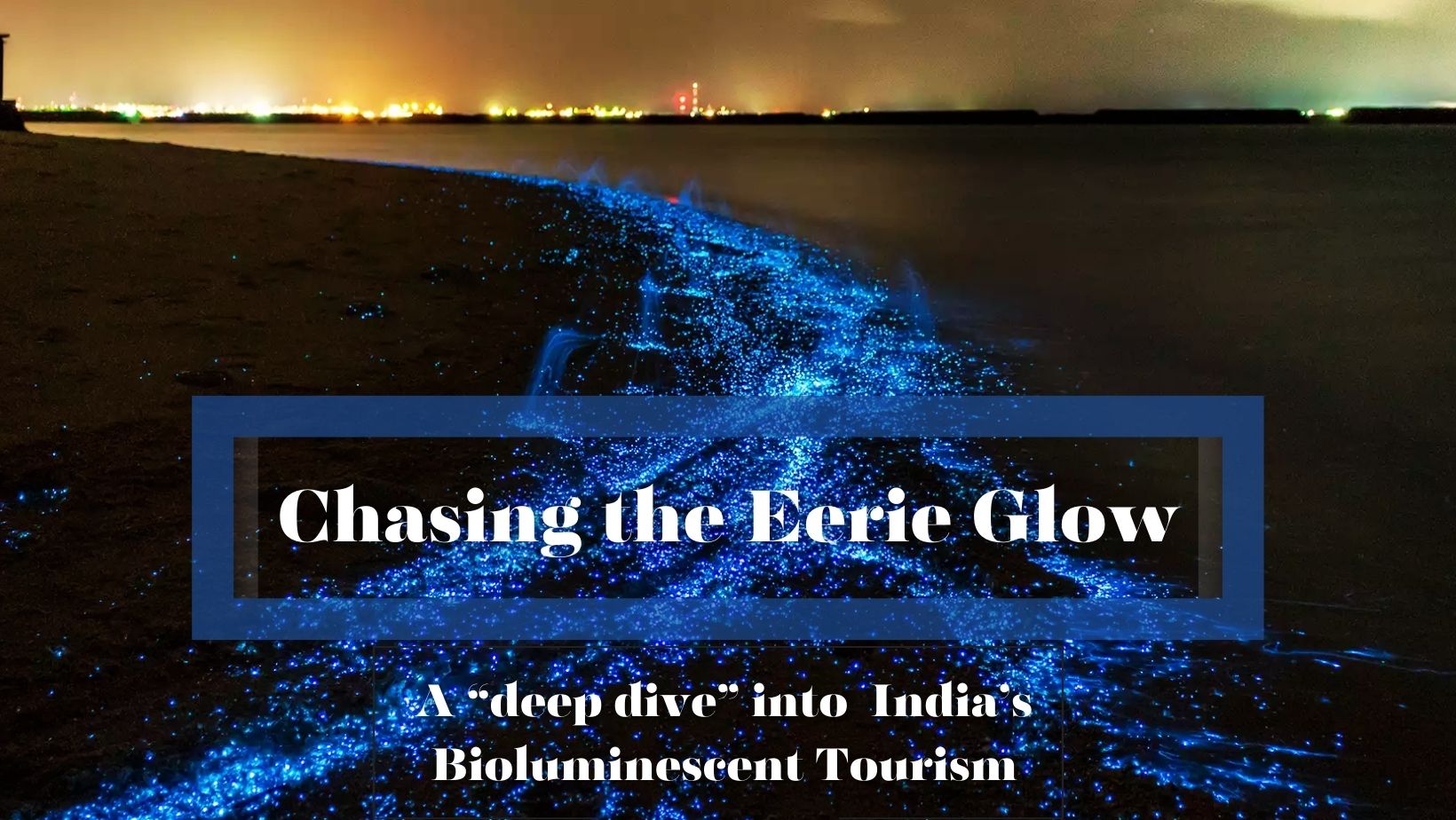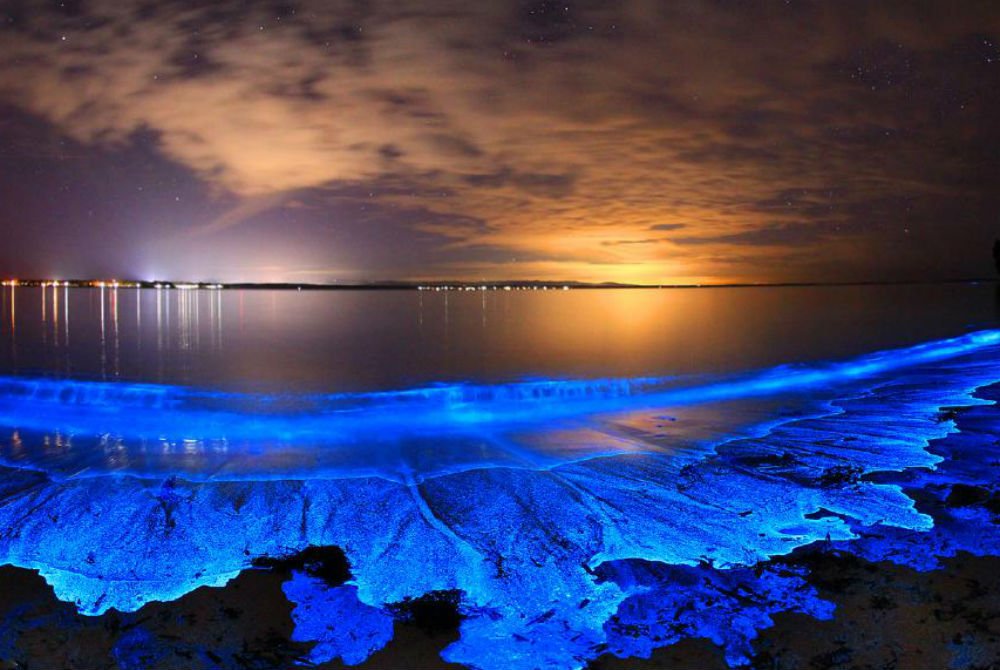Imagine a night beach, washed with the “whishh whoosh” sounds of waves rising and falling. As you dip your feet into the cool water, the sand beneath you erupts into an eerie glimmer of blue light that takes you by surprise as your breath hitches.
No, this is not “straight out of a Nolan film”, but is an IRL phenomenon termed as Bioluminescence.
Still saying, not Nolan.
India, with its diverse and vast landscapes, acts as a treasure trove for thrill-seekers, scholars, travel junkies and those wishing for peace and quiet alike. India, rife with its Bioluminescent coastlines, act as the perfect spots for all those seeking such an ethereal experience.
First off, Bioluminescence? huh?
Bioluminescence is a natural phenomenon where living organisms produce and emit light. This mesmerizing display results from a chemical reaction within their bodies, where a molecule called luciferin reacts with oxygen in the presence of an enzyme called luciferase, releasing energy in the form of light.
Imagine: a thousand fireflies illuminating the night sky, the glow of planktons in the ocean, or an eerie glow emanating from ‘glowing mushrooms’ in the forest; just a few examples of bioluminescence.
How exactly does this happen and….why?
Although, the exact reason for bioluminescence varies across different species, it serves several crucial purposes that include:
- Attracting mates: Insects, like fireflies, use light to attract potential partners.
- Luring prey: Certain organisms, like deep-sea fish, utilize bioluminescence to lure unsuspecting prey.
- Camouflaging and defense: Certain creatures use bioluminescence flashes to startle predators or blend in with their surroundings.
- Essential for communication: Species, like bacteria, communicate with each other using light signals.
Bioluminescence is not just a mesmerizing spectacle; it is a phenomenon that is both visually appealing and ecologically significant, serving as an important tool for and into scientific research.
Okay so, this eerie glow, where in India can one witness it?
Now, India boasts of a multitude of bioluminescent hotspots, each offering unique and unforgettable experiences. Here are a few that will most definitely make your jaw drop, and we mean it:
- The Glowing Waters of Havelock Island:
Radhanagar Beach, nestled within the Andaman and Nicobar Islands, is renowned for its white sand and pristine waters. But at night, the real magic unfolds, as you wade through the knee-deep water, you can see planktons transforming the sea into a sparkling tapestry of blue.
2. Firefly Symphony in Purushwadi:
In the heart of Maharashtra, nestled amidst the Western Ghats, lies the village of Purushwadi. During the monsoon months, the village transforms into a magical spectacle, as millions of fireflies orchestrate a dance of light, illuminating the hills and valleys.
3. Underwater Glow in Lakshadweep:
The coral reefs of Lakshadweep are home to a plethora of bioluminescent organisms, including dinoflagellates and jellyfish. Witnessing these creatures illuminate the underwater world during a night dive is an experience unlike any other.
4. Bioluminescent Bay of Kerala:
Have you watched Kumbalangi Nights? No? Nevermind, you missed out on a hit, but that’s besides the point. A charming fishing village in Kerala, Kumbalangi is blessed with a bioluminescent bay. During the summer months, the water teems with planktons, creating a mesmerizing spectacle that has drawn tourists from far and wide.
5. Beaches across Maharashtra and Dakshina-Kannada Udupi Coast!
You wont believe it but at Juhu Beach Devgad and Velas Beach in Ratnagiri and Dakshina-Kannada Udupi Coast one could witness the blue tides, which ofcourse gave rise to curiosity and maybe even panic? Especially from November to January and in the month of March, this phenomenon could be witnessed in several parts of Indian coastlines.
Let’s talk Bioluminescent Tourism, a new potential scope?
Bioluminescent tourism in India is experiencing a surge in popularity, drawing travelers from around the world to witness the captivating spectacle of living organisms emitting an eerie blue glow. This immersive experience offers a unique blend of natural wonder and eco-conscious travel, contributing to both environmental conservation and local community development.
The tourism industry is thriving at the moment with several factors including phenomena such as bioluminescence that draw in tourists, among other factors. Now this is primarily because of reasons such as sustainable tourism practices, community empowerment, awareness tactics and more.
Responsible tourism practices are prioritized, including eco-lodges, local guides, and minimizing light pollution to protect these fragile ecosystems. Several local communities benefit directly through tourism opportunities, thus helping create sustainable livelihoods. The growing awareness of bioluminescence and its eco-friendly nature has led to an increase in tourist interest, boosting the local economy.
Bioluminescent tourism in India is not just a trend; it’s a movement with the potential to contribute significantly to both environmental preservation and community development. However, it’s crucial to remember that responsible tourism is paramount and to ensure the sustainability of these ecosystems, it’s important to always prioritize eco-friendly measures, methods and choices.
By embracing responsible practices and fostering collaboration, India can continue to shine in this captivating and sustainable form of tourism.














